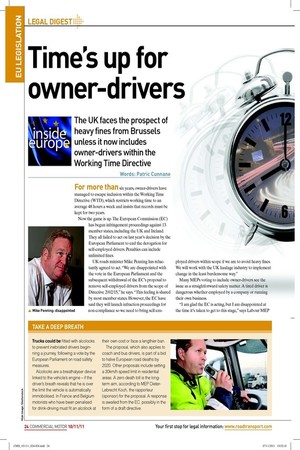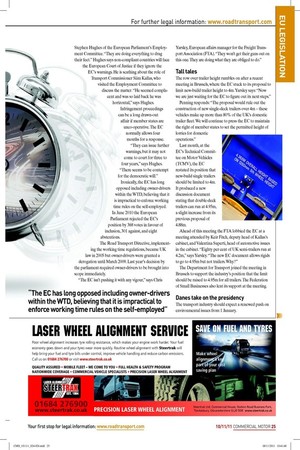Time’s up for owner-drivers
Page 18

Page 19

If you've noticed an error in this article please click here to report it so we can fix it.
The UK faces the prospect of heavy fines from Brussels unless it now includes owner-drivers within the Working Time Directive
Words: Patric Cunnane For more than six years, owner-drivers have managed to escape inclusion within the Working Time Directive (WTD), which restricts working time to an average 48 hours a week and insists that records must be kept for two years.
Now the game is up. The European Commission (EC) has begun infringement proceedings against 13 member states, including the UK and Ireland. They all failed to act on last year’s decision by the European Parliament to end the derogation for self-employed drivers. Penalties can include unlimited ines.
UK roads minister Mike Penning has reluctantly agreed to act. “We are disappointed with the vote in the European Parliament and the subsequent withdrawal of the EC’s proposal to remove self-employed drivers from the scope of Directive 2002/15,” he says. “This feeling is shared by most member states. However, the EC have said they will launch infraction proceedings for non-compliance so we need to bring self-em ployed drivers within scope if we are to avoid heavy ines. We will work with the UK haulage industry to implement change in the least burdensome way.” Many MEPs voting to include owner-drivers see the issue as a straightforward safety matter. A tired driver is dangerous whether employed by a company or running their own business.
“I am glad the EC is acting, but I am disappointed at the time it’s taken to get to this stage,” says Labour MEP Stephen Hughes of the European Parliament’s Employment Committee. “They are doing everything to drag their feet.” Hughes says non-compliant countries will face the European Court of Justice if they ignore the EC’s warnings. He is scathing about the role of Transport Commissioner Siim Kallas, who visited the Employment Committee to discuss the matter. “He seemed complacent and was so laid back he was horizontal,” says Hughes.
Infringement proceedings can be a long drawn-out affair if member states are unco-operative. The EC normally allows four months for a response.
“They can issue further warnings, but it may not come to court for three to four years,” says Hughes. “There seems to be contempt for the democratic will.” Ironically, the EC has long opposed including owner-drivers within the WTD, believing that it is impractical to enforce working time rules on the self-employed. In June 2010 the European Parliament rejected the EC’s position by 368 votes in favour of inclusion, 301 against, and eight abstentions.
The Road Transport Directive, implementing the working time regulations, became UK law in 2005 but owner-drivers were granted a derogation until March 2009. Last year’s decision by the parliament required owner-drivers to be brought into scope immediately.
“The EC isn’t pushing it with any vigour,” says Chris Yarsley, European affairs manager for the Freight Transport Association (FTA). “They won’t get their guns out on this one. They are doing what they are obliged to do.”
Tall tales
The row over trailer height rumbles on after a recent meeting in Brussels, where the EC stuck to its proposal to limit new-build trailer height to 4m. Yarsley says: “Now we are just waiting for the EC to igure out its next steps.” Penning responds: “The proposal would rule out the construction of new single-deck trailers over 4m – these vehicles make up more than 80% of the UK’s domestic trailer leet. We will continue to press the EC to maintain the right of member states to set the permitted height of lorries for domestic operations.” Last month, at the EC’s Technical Committee on Motor Vehicles (TCMV), the EC restated its position that new-build single trailers should be limited to 4m. It produced a new discussion document stating that double-deck trailers can run at 4.95m, a slight increase from its previous proposal of 4.88m.
Ahead of this meeting the FTA lobbied the EC at a meeting attended by Keir Fitch, deputy head of Kallas’s cabinet, and Valentina Superti, head of automotive issues in the cabinet. “Eighty per cent of UK semi-trailers run at 4.2m,” says Yarsley. “The new EC document allows rigids to go to 4.95m but not trailers. Why?” The Department for Transport joined the meeting in Brussels to support the industry’s position that the limit should be raised to 4.95m for all trailers. The Federation of Small Businesses also lent its support at the meeting.











































